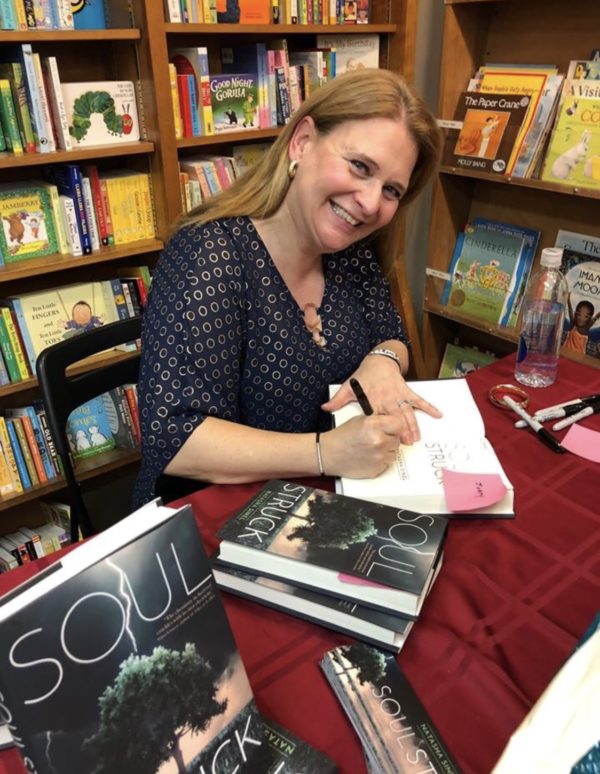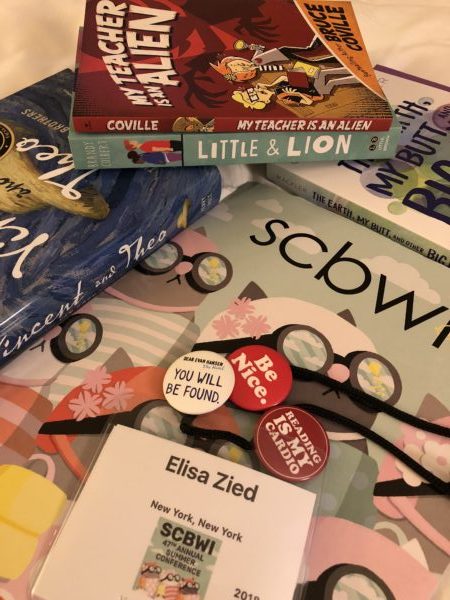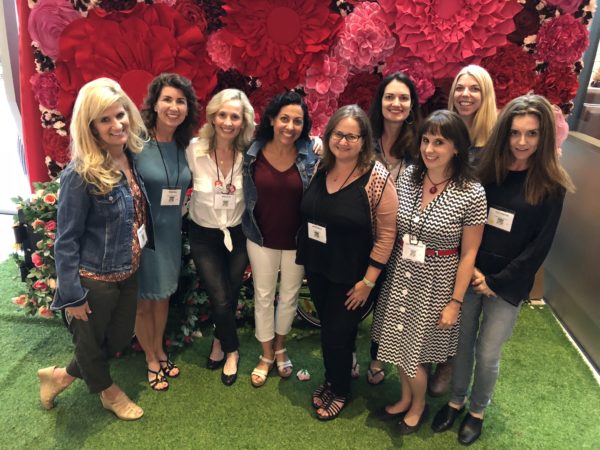Soulstruck: Interview with YA Author Natasha Sinel
 If you’re intrigued by the idea of soulmates and are fascinated by fate, Soulstruck (Sky Pony Press, June 12, 2018) may belong in your hands and on your bookshelf. Here’s a description of Natasha Sinel’s sophomore young adult novel:
If you’re intrigued by the idea of soulmates and are fascinated by fate, Soulstruck (Sky Pony Press, June 12, 2018) may belong in your hands and on your bookshelf. Here’s a description of Natasha Sinel’s sophomore young adult novel:
She might be only a lightning bolt away from finding her soul mate.
Seventeen-year-old Rachel Ferguson is trying to get struck by lightning. Maybe it will lead to finding her soul mate, like it did for her mother. And then maybe her mom will be as devoted to her as she is to her lightning strike survivors group.
When Rachel discovers letters written by her mother’s soul mate—the man she thought was her father—she begins to question everything she’s always believed, including soul mates, fate, and even her mother. No longer sure of its power, she decides to quit chasing lightning.
Rachel feels abandoned and alone—her best friend has ditched her, her boyfriend has dumped her, and confronting her mom only made things worse. At least she still has her friend Jay—in fact, their growing attraction to each other seems to be the only good thing happening.
But when her relationship with Jay starts to unravel too, the impulse to get struck by lightning resurfaces.
And there’s a thunderstorm coming.
Set in a small Cape Cod beach town in the off-season, SOULSTRUCK is about the search for love, and the risk of losing it while waiting for destiny to happen.
I had the pleasure of doing an email Q & A with Sinel. Read below to learn more about her and her writing life.
EZ: Now that you’re a seasoned novelist with two titles, how would you compare the process of writing your first novel, The Fix, with that of Soulstruck?
NS: A seasoned novelist? Ha! That’s super nice of you to say. While I did feel more confident this time around, writing a new novel still feels like starting from scratch. I think it’s safe to say that writing Soulstruck was just as difficult as writing The Fix! My novels have always started out as one thing and inevitably evolved into something very different. So I end up rewriting a few times as I discover my characters’ emotional arcs and the themes. It’s a long process, but so far it’s worked for me. I’m always looking for new processes to help streamline drafting and revising, but I usually end up doing what has always worked for me—basically, there’s no way out but through!
EZ: What’s the best thing you learned as a first-time author (related to writing, book promotion, etc.) that has helped you moving forward?
NS: I learned what a lot of debut authors learn—self-promotion is uncomfortable and it kind of sucks. Also, I’ve gotten much better at letting things go—like the little jealousies that arise about other authors getting sent to conferences or festivals, etc. I’m learning that sometimes it happens, and sometimes it doesn’t. Even with Soulstruck coming out, I’ve been much more focused on revising my current work in progress than on the release. I’m getting much better at doing what everyone says to do—just keep writing. The only thing we really have control over as authors is the writing.
EZ: What was the spark that lead to the idea that became Soulstruck?
NS: Back in 1991 there was a lightning strike at a high school lacrosse game in Washington, DC (where I’m from)—more than ten people were struck, and one teenager was killed. A young EMT who happened to be there saved several people’s lives that day. I wasn’t there but I’d heard about it and the story always stuck with me. An idea started to form in my head and as I researched lightning and the lightning strike survivors, my characters came into focus and my story began.
EZ: What was the most challenging part of writing Soulstruck?
NS: Some of my ideas in the beginning forced me toward a more paranormal storyline and, as I’m much more comfortable with realistic writing, it felt uncomfortable. I moved forward with it, though, because I remembered a former writing instructor saying it’s better to go big to start out and then you can always scale back. So that’s what I did. Though it was strange letting go of so much of the original idea I’d written, in the end, it was what was best for the story.
EZ: What was the best/most exciting or fulfilling part about writing Soulstruck?
NS: I always love those a-ha moments that come when you least expect it—as you’re falling asleep, taking a walk, in the shower. It makes me realize how hard my subconscious is working on my stories all of the time. One of my favorite moments was after I’d gotten some amazing editorial notes from my agent Linda Epstein, and I was in despair because the notes were BIG—like, really big. I let it all swirl around for a few days and then I got to work. I took out about 15k words. And added about 15k words. After I was finished, it was so much better, and when we sent it off to my editor, she loved it.
EZ: How did you get the idea for “Moving the Body,” your short story that appears in the recent adoption-themed anthology, Welcome Home? Was it something you had worked on before, or did you write it specifically for the anthology? And how excited were you to be asked (such an honor that must have been)!
NS: It was such an honor to be a part of Welcome Home. Eric Smith is amazing, and it was so wonderful to work with him. The anthology as a whole is really very special. And yes, I wrote Moving the Body specifically for the anthology! A few things came together to inspire the idea—one: I wanted to show that the bond between an adopted child and his mom can be as close as the bond between a biological child and his mom, two: I’d read a horrifying article about a teen in the UK who became involved with someone through an online game and the results were devastating, and three: right around the same time, there was an incident in my town—kids had spray-painted a swastika on a neighbor’s garage, and later it came out that a few of the kids were Jewish. Those three things did a little dance in my head, and out came my story.
EZ: Would you say you’re a one-book-at-a-time kind of author or can you work on multiple projects at once?
NS: So far, I work on one book at a time, though recently, when I was having difficulty with my work-in-progress, I wrote a few scenes for a new idea rather than skip a day of working. That was fun, and I could see myself doing that more.
EZ: Any advice for writers struggling to get their butts in the chair to just write?
NS: Ugh. It’s just so hard. There’s no way around it. Some things that help me are: 1. getting my butt in the chair right after putting my kids on the bus, so I don’t keep putting it off all day, 2. talking things out with my critique partner or setting up check-in times with her, 3. setting a timer for 25 minutes and committing to writing for just that amount of time—often, I’ll get on a roll and keep going, 4. writing a kissing scene or something I love even if it’s not the next scene I need to write. But some days, it just won’t happen. I try not to let it bring me down so I can start fresh the next day.
EZ: Anything exciting on the writing horizon for you?
NS: I’m finishing up a manuscript and getting ready to send it to my agent. I really have my fingers crossed for this one. And once I send it to her, I’ll get started on my next idea, which will require some research that I’m really excited about.
EZ: What’s currently on your book shelf?
NS: Lots of contemporary YAs: Monday’s Not Coming by Tifany D. Jackson, Foolish Hearts by Emma Mills, Sarah Dessen (I’m catching up on all of her books, way behind!), The Secret History of Us by Jessi Kirby, The Nowhere Girls by Amy Reed, and I can’t wait to read my agent-sister Miriam McNamara’s debut The Unbinding of Mary Read. I could go on…
EZ: Any favorite TV shows you’re currently enjoying?
NS: I read a lot more than I watch TV, but currently I’m watching The Handmaid’s Tale, Younger, and The Bold Type.
To learn more about Natasha Sinel and her work, visit her website here.
Full disclosure: Sinel’s publisher sent me an ARC of her book. I did, however, buy my own copy and cannot wait to get it signed!
 This weekend, I geeked out at the Society for Children’s Book Writers and Illustrators Summer Conference in Los Angeles, California. With homework and deadlines approaching, I was nervous about attending, wondering whether I could really afford to lose valuable study time. And of course I felt some Jewish mom guilt to leave my family less than a week after my 16-year-old returned from a summer program. Fortunately, I got a lot of reading and writing done on my 6-hour flight (with an additional hour on the runway). And while three full days of panels, workshops and keynotes with an amazing faculty of authors, agents and editors kept us busy, it was unbelievably inspiring and well worth every minute.
This weekend, I geeked out at the Society for Children’s Book Writers and Illustrators Summer Conference in Los Angeles, California. With homework and deadlines approaching, I was nervous about attending, wondering whether I could really afford to lose valuable study time. And of course I felt some Jewish mom guilt to leave my family less than a week after my 16-year-old returned from a summer program. Fortunately, I got a lot of reading and writing done on my 6-hour flight (with an additional hour on the runway). And while three full days of panels, workshops and keynotes with an amazing faculty of authors, agents and editors kept us busy, it was unbelievably inspiring and well worth every minute.

Recent Comments